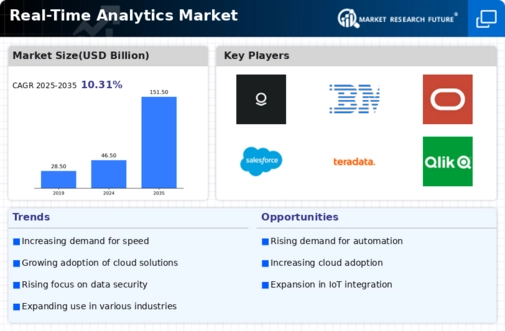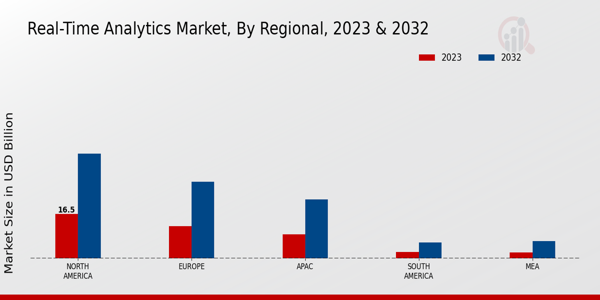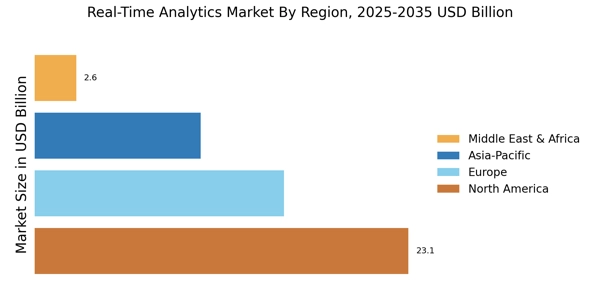Increased Focus on Customer Experience
The Real-Time Analytics Market is significantly influenced by the growing emphasis on enhancing customer experience. Organizations are increasingly utilizing real-time analytics to gain insights into customer behavior and preferences, allowing them to tailor their offerings accordingly. This focus on customer-centric strategies is evident in various sectors, including e-commerce, hospitality, and telecommunications. Data indicates that companies that prioritize customer experience are likely to achieve higher customer retention rates and increased revenue. By leveraging real-time analytics, businesses can respond promptly to customer inquiries, personalize marketing efforts, and optimize service delivery. This trend highlights the critical role of real-time data in fostering customer loyalty and satisfaction, ultimately driving growth within the Real-Time Analytics Market.
Regulatory Compliance and Risk Management
The Real-Time Analytics Market is also shaped by the increasing need for regulatory compliance and effective risk management. Organizations are under constant pressure to adhere to various regulations, particularly in sectors such as finance and healthcare. Real-time analytics provides businesses with the tools necessary to monitor compliance and identify potential risks proactively. For example, financial institutions are utilizing real-time data to detect fraudulent activities and ensure adherence to regulatory standards. The ability to analyze data in real-time not only aids in compliance but also enhances overall risk management strategies. As regulatory frameworks continue to evolve, the demand for real-time analytics solutions that facilitate compliance and risk mitigation is expected to grow, further influencing the dynamics of the Real-Time Analytics Market.
Rising Importance of Data-Driven Strategies
In the current landscape, the Real-Time Analytics Market is witnessing a pronounced shift towards data-driven strategies. Organizations are increasingly leveraging real-time analytics to inform their strategic decisions, thereby enhancing their overall performance. The integration of real-time data into business processes allows companies to identify trends, optimize operations, and improve customer engagement. Recent data suggests that businesses utilizing real-time analytics are 5 times more likely to make faster decisions than their competitors. This trend underscores the necessity for organizations to invest in advanced analytics solutions that facilitate immediate insights. As the volume of data generated continues to grow exponentially, the demand for tools that can process and analyze this data in real-time is likely to escalate, further propelling the growth of the Real-Time Analytics Market.
Growing Demand for Real-Time Decision Making
The Real-Time Analytics Market is experiencing a surge in demand for immediate decision-making capabilities. Organizations across various sectors are increasingly recognizing the value of real-time data in enhancing operational efficiency and responsiveness. According to recent estimates, the market for real-time analytics is projected to reach approximately 30 billion dollars by 2026, reflecting a compound annual growth rate of around 25%. This growth is driven by the need for businesses to adapt swiftly to changing market conditions and consumer preferences. As companies strive to maintain a competitive edge, the ability to analyze data in real-time becomes paramount. This trend is particularly evident in industries such as retail, finance, and healthcare, where timely insights can lead to improved customer satisfaction and operational performance.
Advancements in Technology and Infrastructure
Technological advancements play a crucial role in shaping the Real-Time Analytics Market. The proliferation of high-speed internet, cloud computing, and advanced data processing technologies has made it feasible for organizations to implement real-time analytics solutions. These advancements enable businesses to collect, store, and analyze vast amounts of data instantaneously. For instance, the adoption of edge computing is allowing data to be processed closer to the source, reducing latency and enhancing the speed of analytics. As a result, organizations can derive insights more quickly and efficiently. Furthermore, the increasing availability of sophisticated analytics tools and platforms is empowering businesses to harness the power of real-time data. This technological evolution is expected to drive significant growth in the Real-Time Analytics Market, as companies seek to leverage these innovations to gain a competitive advantage.



















Leave a Comment